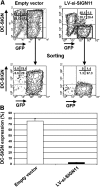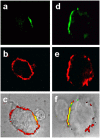DC-SIGN-mediated infectious synapse formation enhances X4 HIV-1 transmission from dendritic cells to T cells
- PMID: 15545354
- PMCID: PMC2211914
- DOI: 10.1084/jem.20041356
DC-SIGN-mediated infectious synapse formation enhances X4 HIV-1 transmission from dendritic cells to T cells
Abstract
Dendritic cells (DCs) are essential for the early events of human immunodeficiency virus (HIV) infection. Model systems of HIV sexual transmission have shown that DCs expressing the DC-specific C-type lectin DC-SIGN capture and internalize HIV at mucosal surfaces and efficiently transfer HIV to CD4+ T cells in lymph nodes, where viral replication occurs. Upon DC-T cell clustering, internalized HIV accumulates on the DC side at the contact zone (infectious synapse), between DCs and T cells, whereas HIV receptors and coreceptors are enriched on the T cell side. Viral concentration at the infectious synapse may explain, at least in part, why DC transmission of HIV to T cells is so efficient.Here, we have investigated the role of DC-SIGN on primary DCs in X4 HIV-1 capture and transmission using small interfering RNA-expressing lentiviral vectors to specifically knockdown DC-SIGN. We demonstrate that DC-SIGN- DCs internalize X4 HIV-1 as well as DC-SIGN+ DCs, although binding of virions is reduced. Strikingly, DC-SIGN knockdown in DCs selectively impairs infectious synapse formation between DCs and resting CD4+ T cells, but does not prevent the formation of DC-T cells conjugates. Our results demonstrate that DC-SIGN is required downstream from viral capture for the formation of the infectious synapse between DCs and T cells. These findings provide a novel explanation for the role of DC-SIGN in the transfer and enhancement of HIV infection from DCs to T cells, a crucial step for HIV transmission and pathogenesis.
Figures






References
-
- Pope, M., and A.T. Haase. 2003. Transmission, acute HIV-1 infection and the quest for strategies to prevent infection. Nat. Med. 9:847–852. - PubMed
-
- Shattock, R.J., and J.P. Moore. 2003. Inhibiting sexual transmission of HIV-1 infection. Nat. Rev. Microbiol. 1:25–34. - PubMed
-
- Steinman, R.M., A. Granelli-Piperno, M. Pope, C. Trumpfheller, R. Ignatius, G. Arrode, P. Racz, and K. Tenner-Racz. 2003. The interaction of immunodeficiency viruses with dendritic cells. Curr. Top. Microbiol. Immunol. 276:1–30. - PubMed
-
- Piguet, V., and A. Blauvelt. 2002. Essential roles for dendritic cells in the pathogenesis and potential treatment of HIV disease. J. Invest. Dermatol. 119:365–369. - PubMed
-
- Pope, M., M.G. Betjes, N. Romani, H. Hirmand, P.U. Cameron, L. Hoffman, S. Gezelter, G. Schuler, and R.M. Steinman. 1994. Conjugates of dendritic cells and memory T lymphocytes from skin facilitate productive infection with HIV-1. Cell. 78:389–398. - PubMed
Publication types
MeSH terms
Substances
LinkOut - more resources
Full Text Sources
Other Literature Sources
Medical
Research Materials

